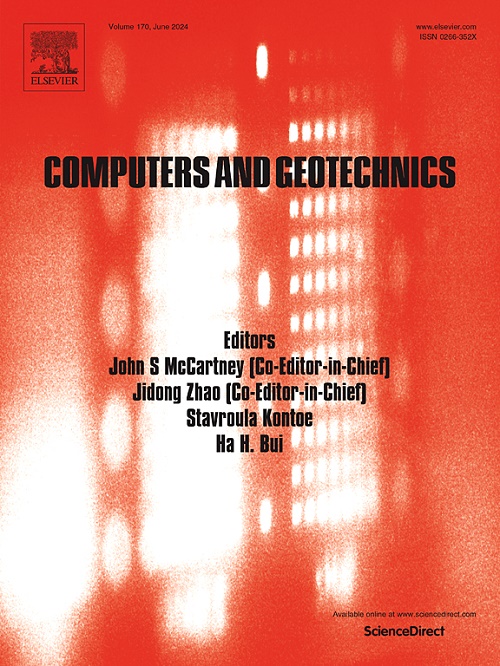SANICLAY-RD:复杂加载路径下速率相关效应的模型
IF 6.2
1区 工程技术
Q1 COMPUTER SCIENCE, INTERDISCIPLINARY APPLICATIONS
引用次数: 0
摘要
粘土的速率依赖行为,包括蠕变、应力松弛和应变速率依赖,在预测土壤行为中起着关键作用。然而,现有的本构模型在捕捉复杂应力路径下的这些影响方面存在局限性,例如由加载-卸载循环产生的应力路径。此外,现有的土壤模型还不能重现从稳定蠕变到延迟破坏的转变。本研究通过提出SANICLAY本构框架(此处称为SANICLAY- rd)的四个增强功能来解决这些缺点。首先,允许投影中心以一种反映延迟变形的现有证据的方式随粘塑性应变演变。其次,提出了一种量化粘塑性变形动力学核心处超应力的静态加载面演化规律。第三,综合考虑实际应力状态和图像应力状态的贡献,采用混合流动规律对复杂加载循环中的粘塑性流动进行调节。最后,允许粘性常数随应力状态动态演化,以捕捉加速蠕变。对现有实验结果的验证表明,该模型能够复制粘土在大范围的过去应力历史和复杂加载周期下的速率依赖行为。此外,该模型被证明可以有效地捕获从稳定(即初级)蠕变到不稳定(即第三级)蠕变的转变。该模型为岩土工程应用中预测土壤的长期行为提供了一个强有力的工具,例如缓慢移动的滑坡的稳定性,以及土基础设施的长期沉降。本文章由计算机程序翻译,如有差异,请以英文原文为准。
SANICLAY-RD: A model for rate-dependent effects under complex loading paths
The rate-dependent behaviours of clay, including creep, stress relaxation, and strain-rate dependency, play a critical role in predicting soil behaviour. However, existing constitutive models exhibit limitations in capturing these effects under complex stress paths, such as those resulting from loading-unloading cycles. Moreover, existing soil models are not yet equipped to reproduce transitions from stable creep to delayed failure. This study addresses these shortcomings by proposing four enhancements of the SANICLAY constitutive framework, here referred to as SANICLAY-RD. First, the projection center is allowed to evolve with the viscoplastic strain in a way that reflects the available evidence for delayed deformation. Second, an evolution law for the static loading surface quantifying the overstress at the core of the viscoplastic deformation kinetics is proposed. Third, a hybrid flow rule is used to adjust the viscoplastic flow during complex loading cycles by considering contributions from both the actual and the image stress states. Finally, the viscous constants are allowed to evolve dynamically with the stress state to capture accelerating creep. Validation against existing experimental results demonstrates the capability of the model to replicate the rate-dependent behaviour of clays subjected to a wide range of past stress histories and complex loading cycles. Additionally, the model is shown to effectively captures the transition from stable (i.e., primary) creep to unstable (i.e., tertiary) creep. This model provides a robust tool for predicting the long-term behaviour of soils in geotechnical applications, such as the stability of slow-moving landslides, as well as the long-term settlement of earthen infrastructures.
求助全文
通过发布文献求助,成功后即可免费获取论文全文。
去求助
来源期刊

Computers and Geotechnics
地学-地球科学综合
CiteScore
9.10
自引率
15.10%
发文量
438
审稿时长
45 days
期刊介绍:
The use of computers is firmly established in geotechnical engineering and continues to grow rapidly in both engineering practice and academe. The development of advanced numerical techniques and constitutive modeling, in conjunction with rapid developments in computer hardware, enables problems to be tackled that were unthinkable even a few years ago. Computers and Geotechnics provides an up-to-date reference for engineers and researchers engaged in computer aided analysis and research in geotechnical engineering. The journal is intended for an expeditious dissemination of advanced computer applications across a broad range of geotechnical topics. Contributions on advances in numerical algorithms, computer implementation of new constitutive models and probabilistic methods are especially encouraged.
 求助内容:
求助内容: 应助结果提醒方式:
应助结果提醒方式:


